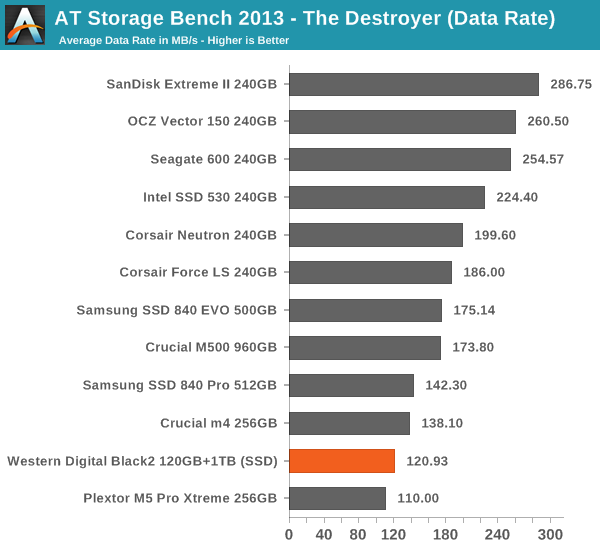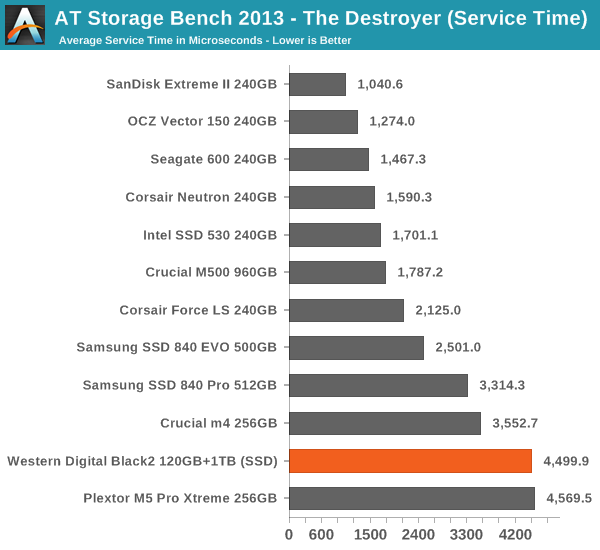The WD Black2 Review: World's First 2.5" Dual-Drive
by Kristian Vättö on January 30, 2014 7:00 AM ESTAnandTech Storage Bench 2013
Our Storage Bench 2013 focuses on worst-case multitasking and IO consistency. Similar to our earlier Storage Benches, the test is still application trace based -- we record all IO requests made to a test system and play them back on the drive we're testing and run statistical analysis on the drive's responses. There are 49.8 million IO operations in total with 1583.0GB of reads and 875.6GB of writes.
As some of you have asked, I'm not including the full description of the test for better readability, so make sure to read our Storage Bench 2013 introduction for the full details.
| AnandTech Storage Bench 2013 - The Destroyer | ||||||||||||
| Workload | Description | Applications Used | ||||||||||
| Photo Sync/Editing | Import images, edit, export | Adobe Photoshop CS6, Adobe Lightroom 4, Dropbox | ||||||||||
| Gaming | Download/install games, play games | Steam, Deus Ex, Skyrim, Starcraft 2, BioShock Infinite | ||||||||||
| Virtualization | Run/manage VM, use general apps inside VM | VirtualBox | ||||||||||
| General Productivity | Browse the web, manage local email, copy files, encrypt/decrypt files, backup system, download content, virus/malware scan | Chrome, IE10, Outlook, Windows 8, AxCrypt, uTorrent, AdAware | ||||||||||
| Video Playback | Copy and watch movies | Windows 8 | ||||||||||
| Application Development | Compile projects, check out code, download code samples | Visual Studio 2012 | ||||||||||
We are reporting two primary metrics with the Destroyer: average data rate in MB/s and average service time in microseconds. The former gives you an idea of the throughput of the drive during the time that it was running the Destroyer workload. This can be a very good indication of overall performance. What average data rate doesn't do a good job of is taking into account response time of very bursty (read: high queue depth) IO. By reporting average service time we heavily weigh latency for queued IOs. You'll note that this is a metric we've been reporting in our enterprise benchmarks for a while now. With the client tests maturing, the time was right for a little convergence.

Our Storage Bench 2013 favors 480GB and bigger drives due to its focus on steady-state performance. Having more NAND helps with worst case performance as ultimately steady-state performance is dictated by the speed of the read-modify-write cycle, which depends on the program and erase times of the NAND. The more NAND the drive has, the higher the probability that there is at least some empty blocks available.
When taking the lower capacity into account, the Black2 isn't terrible but it's not great either. There are some 256GB drives that perform similarly, although it should be noted that the Black2 has 12% over-provisioning instead of 7%, giving it a slight advantage there (the drives are filled with sequential data before the test after all).











100 Comments
View All Comments
nitram_tpr - Thursday, January 30, 2014 - link
Ouch, that is one expensive drive. As you say, it appears to be the ideal solution for a laptop with only a single drive bay. I think there is another option - change the HDD for an SSD and put the HDD into the optical drive bay with an adapter.ddriver - Thursday, January 30, 2014 - link
It is kind of expensive and kind a slow and power hungry for an SSD, but still it is essentially 2 hard drives in one. I would actually get this if the SSD part was a tiny bit better. I don't think the presence of mechanical drive in the case mandates the SSD performance be any lower. I think I will just install an extra drive in the optical drive bay, seriously DELL what were you thinking who uses optical storage in 2012?lmcd - Thursday, January 30, 2014 - link
Me.Thanks Dell for considering :-)
ddriver - Thursday, January 30, 2014 - link
Poor you :) I maintain about 20 TB of data, in the past the database was much smaller so I used to back it up on CDs, then DVDs, but the damn things are just too slow, unreliable, small and the cost of storage was very high. It was this moment I began hating optical storage with passion, my life got marginally better when I destroyed all optical disks and moved everything to hard drives - faster, cheaper, more compact and reliable.I know manufacturers provide installation disks which some people end up using for years, failing to realize the software on that disk is usually out of data before they even made the purchase.
And for all scenarios a hard drive is overkill there is the USB flash drive.
I guess optical storage makes some sense on consoles and/or media center PCs, if you watch many bluray or dvd movies, but for everything else... meh... and on that dell laptop it is just dead weight and battery drain.
Morawka - Thursday, January 30, 2014 - link
Try blu ray man, blu ray's will match HDD's capacity in the near future. At present, it can already match SSD's capacity of 128GB.The blu ray tech is good up to 25 layers @ 32 GB per layer = 800 GB
Optical is far from dead when America has some of the worst bandwidth in the world.
Gigaplex - Thursday, January 30, 2014 - link
So I'd need 5 Blu-ray discs per hard drive, which would take 15 hours to write at 16x speed.JHBoricua - Thursday, January 30, 2014 - link
But what happens when one of those 4TB drives fails? Assuming you have them in a RAID array, it will probably take as long or longer for the array to rebuild, not to mention that at those capacities, the risk of another drive failing during the rebuild are simply too great if you care about your data.ddriver - Friday, January 31, 2014 - link
I don't raid, I just backup. This is IMO better. I could raid something for performance but never for safety.name99 - Friday, January 31, 2014 - link
Jesus, You sound like iOmega with the endless succession of ZIP and JAZ drives, or Cringely talking up his aluminum foil based drive (which still has not seen the light of day).So the best Blu-Ray could do (in drives that don't exist, using disks that don't exist) is a very slow version of a drive that I can buy for around $50?
Good luck getting rich with that particular technology.
Optical is dead dead dead. And quit whining about "worst bandwidth in the world" you drama queen. Go to a real third world country and see what really bad connectivity looks like. The only problem most Americans have is that they will have to wait five minutes for their drivers to download rather than 20 seconds. That's just not enough pain to keep optical relevant.
TheinsanegamerN - Saturday, February 1, 2014 - link
you forget the very restrictive bandwidth caps, the terrible customer service, the awful reliability, the throttling of data, the list goes on.